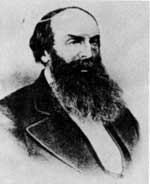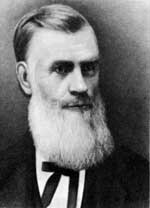|
WHITMAN MISSION National Historic Site |
 |
Those Who Answered the Call
 Henry Harmon Spalding, from a photograph taken several years after the massacre. WHITMAN COLLEGE |
 William Henry Gray. WHITMAN COLLEGE |
On March 31, 1836, the Whitmans and Spaldings left St. Louis aboard the Chariton for Liberty, Mo., the jumping-off place for the West. In Liberty they were joined by the fifth member of the party, William H. Gray.
Marcus Whitman's experience, gained in the preceding year on his trip to the Rockies, together with his dedication to the purpose of the trip, made him the natural leader of the little group. Born in 1802 in Rushville, N.Y., Marcus was 8 when his father died, and the boy then went to live with an uncle. Following classical school, he had hoped to prepare for the ministry. But a lack of money and his family's disinterest in this career caused him to turn to medicine.
Whitman began riding with the local doctor, and in 1825 he entered a medical school in Fairfield, N.Y. Following practice in New York and Canada, Whitman settled in the town of Wheeler, N.Y. Before long, he became interested in medical missionary work. He concluded that his medical training and religious interests could be well combined in this field. His first application to the American Board for a mission assignment was turned down because of poor health. But after Dr. Samuel Parker interviewed him in 1835, the Board reconsidered and selected Marcus as a medical missionary.
Narcissa Whitman was in many ways a contrast to her husband. Though he was sober and serious, Narcissa was animated and vivacious. Attractive in face and figure, endowed with a fine voice, she was a person of confidence and poise. Born in Prattsburg, N.Y., in 1808, Narcissa Prentiss attended Emma Willard's "Female Seminary" in Troy and afterwards Franklin Academy in Prattsburg. She taught school for several years and then applied for the mission field. In her first attempt she too was turned down by the Board. It did not want single women for missionary work. But after her engagement to Marcus, the Board approved her application. The trip to Oregon was her honeymoon.
Riding with Marcus and Narcissa was a man whose marriage proposal Mrs. Whitman is said to have once turned down, the Reverend Henry Harmon Spalding. Spalding was born at Bath, N.Y., in 1803, the child of an unwed mother. Bound out to foster parents at 14 months, he endured an unhappy childhood. The jeers and name-calling to which he was subjected by his stepfather and others left a bitter memory. By nature he was shy, quick tempered, and impatient with those who disagreed with him.
Spalding attended Franklin Academy, where he first met Narcissa Prentiss. After Franklin, he attended Western Reserve College in Hudson, Ohio and Lane Theological Seminary in Cincinnati. Upon completion of his studies, he was ordained in the Presbyterian Church. In 1831 he met Eliza Hart of Holland Patent, N.Y., and they were soon married.
|
Pictures of the Whitmans The camera had not made its appearance in the Pacific Northwest before the deaths of Marcus and Narcissa Whitman. Though artists visited the mission before the massacre, no known likenesses of the Whitmans have ever been found. Thus the few sketches that have been made of Marcus and his wife are conjectural drawings, the better ones based on descriptions written by those who knew them. |
Born in 1807 in Kensington, Conn., Eliza Hart grew into a studious and deeply religious person. In appearance she was tall, dark, and coarse of feature and voice; but she had a quiet charm that endeared her to those who knew her. Of them all, Eliza was best fitted by temperament to work among the Indians, but even she did not realize that the Indians' first loyalty was to themselves and not to the whites and their ways.
William H. Gray, appointed to the Oregon mission as mechanic and carpenter, was born in Fairfield, N.Y., in 1810. His father died when William was 16, and he was apprenticed. to a cabinetmaker. His best talents were in the use of his hands, but his ambitions always exceeded ordinary callings. His manual skills were to be of value to the missionaries, but his undependable temper and habit of complaining were to lead to serious complications for the missions of Oregon.
At Liberty, Mo., these five now made their final preparations for the trip across the Great Plains and over the Rockies to the still-strange land called Oregon in order to bring their faith to the Indians.
|
|

|
|
Last Modified: Sat, Sep 28 2002 10:00:00 pm PDT |


